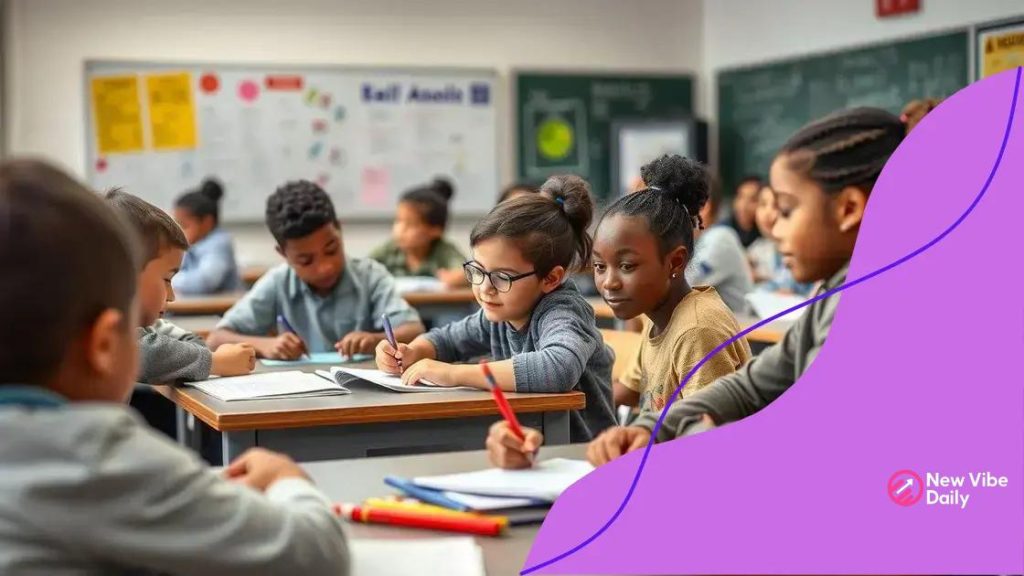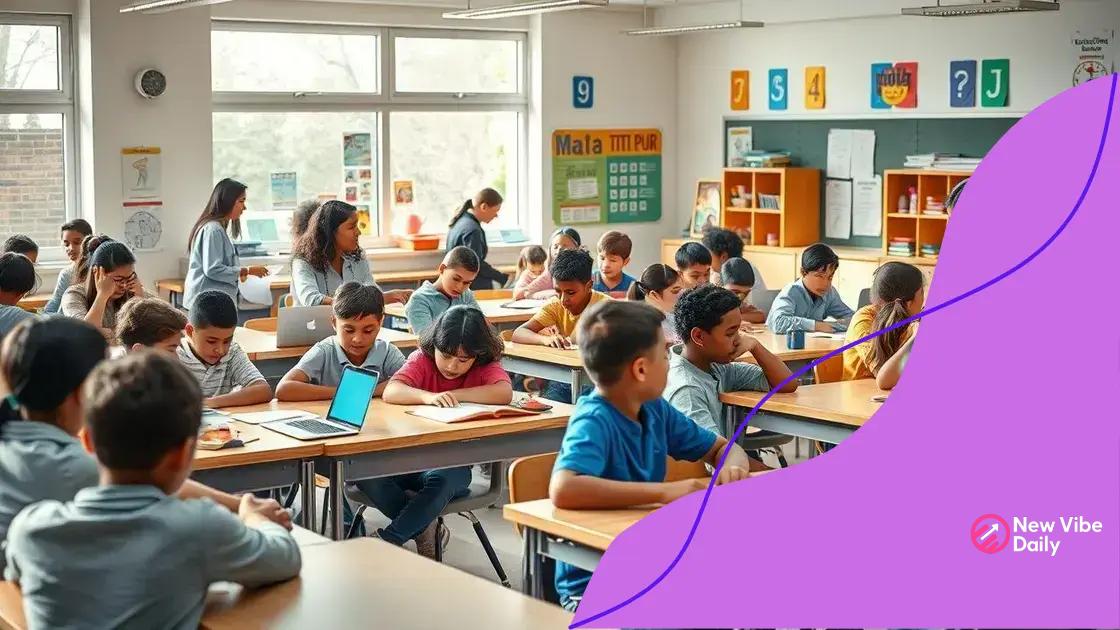Inclusive teaching training: Transform your classroom today

Building a supportive community in education enhances student success by fostering collaboration among educators, engaging parents, and empowering student voices, ultimately creating an inclusive and nurturing learning environment.
Inclusive teaching training is essential for fostering an environment where every student feels valued and supported. Ever wondered how to adapt your methods to embrace diverse learning needs? Let’s explore practical strategies that can elevate your teaching.
Understanding the concept of inclusive teaching
Understanding the concept of inclusive teaching is essential for creating an equitable learning environment. It ensures that every student, regardless of their background or abilities, is given the opportunity to succeed. But what does it really mean to teach inclusively?
What is Inclusive Teaching?
Inclusive teaching refers to a range of teaching strategies that aim to address the diverse needs of all students. It goes beyond simply providing accommodations for students with disabilities. Instead, it encourages active participation from all learners. This means recognizing each student’s unique strengths and backgrounds.
One effective way to incorporate inclusive teaching is by using varied teaching methods. For instance, incorporating group activities, visual aids, and technology can enhance understanding. Additionally, fostering a classroom environment where every voice is valued promotes engagement and participation. This is crucial in making all students feel included.
Key Components of Inclusive Teaching
- Differentiation: Tailoring lessons to meet the varied learning styles and needs of students.
- Collaboration: Working together with colleagues, families, and community resources to support learners.
- Flexibility: Adjusting teaching strategies based on students’ responses and changing needs.
Moreover, inclusive teaching encourages teachers to reflect on their practices. By regularly asking questions like, “How can I support my students better?” teachers can continuously improve their approach. A focus on ongoing assessment helps teachers understand how to adapt lessons to fit student needs.
Ultimately, the goal is to create a learning space where all students feel safe and motivated. Implementing inclusive practices isn’t just beneficial for students with disabilities; it enhances the learning experience for every student in the class. Encouraging diverse interactions and perspectives makes for a richer educational environment.
The importance of training for educators
The importance of training for educators cannot be overstated. Effective training equips teachers with the skills they need to implement inclusive teaching practices successfully. It empowers them to understand and cater to the diverse needs of all students.
Enhancing Professional Skills
Professional development opportunities allow educators to expand their knowledge and apply new strategies in their classrooms. Training sessions often provide practical tools that boost classroom engagement. These tools help create a more dynamic learning environment.
Without continual training, teachers may rely on outdated techniques that do not address the needs of today’s diverse student population. It is essential for educators to remain open to learning and adapting their methods.
Building a Supportive Learning Atmosphere
- Collaboration: Training fosters a sense of community among educators, enabling them to share best practices and resources.
- Confidence: Well-trained teachers feel more confident in their ability to manage diverse classrooms.
- Student Success: Continuous training directly impacts student achievements, increasing overall performance.
Moreover, engaging in professional development helps teachers reflect on their teaching practices. Educators are encouraged to ask questions about their effectiveness and consider feedback from peers and students. This self-reflection is crucial in fostering a growth mindset.
Ultimately, the continuous professional development of educators enhances not just their skills but also the overall learning experience of students. By investing in teacher training, schools create a more inclusive environment where all students can thrive.
Strategies for implementing inclusive practices

Implementing inclusive practices effectively requires thoughtful strategies that cater to various learning needs. These strategies help create an environment where every student feels valued and supported, which is essential for fostering success.
Utilizing Diverse Teaching Methods
One effective strategy for inclusive education is utilizing diverse teaching methods. This can include a mix of visual aids, hands-on activities, and technology to engage students. For example, using multimedia resources can assist in addressing different learning styles.
Additionally, incorporating group work allows students to collaborate and learn from each other. This type of interaction enhances social skills and builds a sense of community in the classroom.
Creating a Flexible Classroom Environment
- Adjustable Seating: Offering various seating arrangements can help meet the comfort and learning needs of all students.
- Accessible Materials: Ensure that all resources are available in formats that everyone can access, including digital and print options.
- Routine Adaptability: Be ready to adapt daily routines based on what works best for your students.
Another important approach is to build strong relationships with students. Understanding their backgrounds and interests allows teachers to tailor lessons that resonate with them. Regular check-ins can help gauge how each student is progressing and feeling in the classroom.
Moreover, engaging families in the learning process enriches the educational experience. Communication with parents about their children’s needs and successes fosters a collaborative approach to learning. When families are involved, students are more likely to succeed.
Professional development is also crucial for educators. Providing training on inclusive practices empowers teachers to implement effective strategies confidently and competently. This training can cover areas such as classroom management, cultural competency, and differentiated instruction.
Assessing the effectiveness of inclusive training
Assessing the effectiveness of inclusive training is vital to ensure that educators are gaining the skills needed to support all students. Proper assessment helps identify areas of strength and areas that need improvement, making it a key part of the training process.
Setting Clear Objectives
One important aspect of assessment is setting clear objectives for what the training should achieve. These objectives should relate directly to the needs of the students and the challenges educators face. By establishing specific goals, it becomes easier to measure success after the training.
For instance, if the goal is to foster collaboration among students, trainers can assess whether teachers are implementing group activities successfully in their classrooms.
Collecting Feedback
- Surveys: Distributing surveys post-training can provide valuable insight into how participants felt about the training content and delivery.
- Observations: Observing classrooms after training allows for direct assessment of how effectively teachers use their new skills.
- Discussions: Conducting follow-up discussions with educators can help understand the challenges they face in applying what they’ve learned.
Gathering feedback not only informs the effectiveness of the training but also strengthens the professional development cycle. It allows trainers to refine future sessions based on past experiences and participant input.
Additionally, measuring student outcomes can provide a clear picture of the impact of inclusive training. If students demonstrate improved engagement or achievement, it suggests that the training is benefitting educators and their teaching methods. When students thrive, it reflects positively on the effectiveness of the training.
By prioritizing assessment, educational institutions can ensure that their training programs create lasting changes in the classroom. This continuous evaluation fosters a culture of improvement, leading to better outcomes for both teachers and students.
Building a supportive community in education
Building a supportive community in education is essential for fostering student growth and success. A strong community enhances learning by creating an environment where everyone feels included and valued.
Collaboration Among Educators
One key aspect of building this community is collaboration among educators. Teachers can benefit from sharing ideas, strategies, and resources. Working together enables them to support each other in addressing the diverse needs of their students.
Frequent meetings and professional development workshops can facilitate these collaborations. Such gatherings provide educators with opportunities to discuss challenges and share effective practices. This teamwork fosters a sense of belonging and collective responsibility.
Engaging Students and Families
- Parent Involvement: Actively involving parents in their children’s education can bridge the gap between school and home. This partnership helps create a network of support.
- Student Voice: Encouraging students to express their opinions and participate in decision-making empowers them and builds their confidence.
- Community Events: Hosting events that bring together students, families, and staff fosters connections and strengthens relationships within the community.
Additionally, creating platforms for student involvement is crucial. When students feel heard and valued, they are more likely to engage with their peers and teachers. This engagement enhances their overall educational experience and promotes a more inclusive atmosphere.
Moreover, using social media and community bulletin boards can enhance communication and engagement with families. Regular updates and information sharing nurture relationships and build trust within the community. When families feel included, they are more likely to support their children’s education.
Ultimately, fostering a supportive community within the educational setting leads to improved student outcomes and a positive school culture. By promoting collaboration and engagement among educators, students, and families, schools can create an environment where every individual thrives.
In conclusion, building a supportive community in education is vital for fostering a nurturing environment where students can thrive. Collaboration among educators, parents, and students strengthens relationships and enhances the learning experience. By engaging families and respecting student voices, schools can create an inclusive atmosphere that promotes success for every learner. Continuous support and shared goals are the keys to building a strong educational community that drives positive change.
FAQ – Frequently Asked Questions about Building a Supportive Community in Education
Why is collaboration among educators important?
Collaboration among educators fosters the sharing of ideas and resources, which enhances teaching practices and benefits student learning.
How can parents get involved in their child’s education?
Parents can get involved by participating in school activities, attending meetings, and communicating regularly with teachers to support their child’s learning.
What is the significance of student voice in schools?
Student voice is important because it empowers students to express their thoughts, leading to increased engagement and a sense of belonging in the classroom.
How can community events strengthen educational support?
Community events bring together students, families, and school staff, fostering connections and support networks that enhance the overall educational experience.






